历史
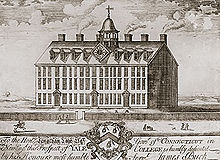
Original building, 1718–1782
The President and Fellows of Yale College, also known as the Yale Corporation, is the governing board of the University.
Origins
Yale traces its beginnings to "An Act for Liberty to Erect a Collegiate School," passed by the General Court of the Colony of Connecticut on October 9, 1701 in an effort to create an institution to train ministers and lay leadership for Connecticut. Soon thereafter, a group of ten Congregationalist ministers: Samuel Andrew, Thomas Buckingham, Israel Chauncy, Samuel Mather, James Noyes, James Pierpont, Abraham Pierson, Noadiah Russel, Joseph Webb and Timothy Woodbridge, all of whom were alumni of Harvard, met in the study of Reverend Samuel Russell in Branford, Connecticut, to pool their books to form the school's first library. The group, led by James Pierpont, is now known as "The Founders."
Originally called the Collegiate School, the institution opened in the home of its first rector, Abraham Pierson, in Killingworth (now Clinton). The school moved to Saybrook, and then Wethersfield. In 1718, the college moved to New Haven, Connecticut.
Meanwhile, a rift was forming at Harvard between its sixth president Increase Mather and the rest of the Harvard clergy, whom Mather viewed as increasingly liberal, ecclesiastically lax, and overly broad in Church polity. The feud caused the Mathers to champion the success of the Collegiate School in the hope that it would maintain the Puritan religious orthodoxy in a way that Harvard had not.
In 1718, at the behest of either Rector Samuel Andrew or the colony's Governor Gurdon Saltonstall, Cotton Mather contacted a successful businessman in Wales named Elihu Yale to ask him for financial help in constructing a new building for the college. Yale, who had made a fortune through trade while living in India as a representative of the East India Company, donated nine bales of goods, which were sold for more than £560, a substantial sum at the time. Yale also donated 417 books and a portrait of King George I. Cotton Mather suggested that the school change its name to Yale College in gratitude to its benefactor, and to increase the chances that he would give the college another large donation or bequest. Elihu Yale was away in India when the news of the school's name change reached his home in Wrexham, North Wales, a trip from which he never returned. While he did ultimately leave his fortunes to the "Collegiate School within His Majesties Colony of Connecticot," the institution was never able to successfully lay claim to it.
Curriculum
Yale was swept up by the the great intellectual movements of the period—the Great Awakening and the Enlightenment—thanks to the religious and scientific interests of presidents Thomas Clap and Ezra Stiles. They were both instrumental in developing the scientific curriculum at Yale, while dealing with wars, student tumults, graffiti, 'irrelevance' of curricula, desperate need for endowment, and fights with the Connecticut legislature.
Serious American students of theology and divinity, particularly in New England, regarded Hebrew as a classical language, along with Greek and 拉丁语, and essential for study of the Old Testament in the original words. The Reverend Ezra Stiles, president of the College from 1778 to 1795, brought with him his interest in the Hebrew language as a vehicle for studying ancient Biblical texts in their original language (as was common in other schools), requiring all freshmen to study Hebrew (in contrast to Harvard, where only upperclassmen were required to study the language) and is responsible for the Hebrew words "Urim" and "Thummim" on the Yale seal. Stiles' greatest challenge occurred in July, 1779 when hostile British forces occupied New Haven and threatened to raze the College. Fortunately, Yale graduate Edmund Fanning, Secretary to the British General in command of the occupation, interceded and the College was saved. Fanning later was granted an honorary degree LL.D., at 1803, for his efforts.
Students
As the only college in Connecticut, Yale educated the sons of the elite. Offenses for which students were punished included cardplaying, tavern-going, destruction of college property, and acts of disobedience to college authorities. During the period, Harvard was distinctive for the stability and maturity of its tutor corps, while Yale had youth and zeal on its side.
The emphasis on classics gave rise to a number of private student societies, open only by invitation, which arose primarily as forums for discussions of modern scholarship, literature and politics. The first such organizations were debating societies: Crotonia in 1738, Linonia in 1753, and Brothers in Unity in 1768.
19th century
The Yale Report of 1828 was a dogmatic defense of the Latin and Greek curriculum against critics who wanted more courses in modern languages, mathematics, and science. Unlike higher education in Europe, there was no national curriculum for colleges and universities in the United States. In the competition for students and financial support, college leaders strove to keep current with demands for innovation. At the same time, they realized that a significant portion of their students and prospective students demanded a classical background. The Yale report meant the classics would not be abandoned. At the same time, all institutions experimented with changes in the curriculum, often resulting in a dual track. In the decentralized environment of higher education in the United States, balancing change with tradition was a common challenge because no one could afford to be completely modern or completely classical. At the same time a group of professors at Yale and New Haven Congregationalist ministers articulated a conservative response to the changes brought about by the Victorian culture. They concentrated on developing a whole man possessed of religious values sufficiently strong to resist temptations from within, yet flexible enough to adjust to the 'isms' (professionalism, materialism, individualism, and consumerism) tempting him from without. Perhaps the most well-remembered teacher was William Graham Sumner, professor from 1872 to 1909. He taught in the emerging disciplines of economics and sociology to overflow classrooms. He bested President Noah Porter, who disliked social science and wanted Yale to lock into its traditions of classical education, 1879-81. Porter objected to Sumner's use of a textbook by Herbert Spencer that espoused agnostic materialism because it might intellectually, morally, and religiously harm students .
Sports and debate
The Revolutionary War hero Nathan Hale (Yale 1773) was the prototype of the Yale ideal in the early 19th century: a manly yet aristocratic scholar, equally well-versed in knowledge and sports, and a patriot who regretted he had but one life to lose for his country. Western painter Frederick Remington (Yale 1900) was an artist whose heroes gloried in combat and tests of strength in the Wild West. The fictional, turn-of-the-century Yale man Frank Merriwell embodied the heroic ideal without racial prejudice, and his fictional successor Frank Stover in the novel Stover at Yale (1911) questioned the business mentality that had become prevalent at the school. Increasingly the students turned to athletic stars as their heroes, especially since winning the big game became the goal of the student body, and the alumni, as well as the team itself.
Along with Harvard and Princeton, Yale students rejected elite British concepts about 'amateurism' in sports and constructed athletic programs that were uniquely American especially football. The Harvard–Yale football rivalry began in 1875.
Between 1892, when Harvard and Yale met in the first intercollegiate debate, and 1909, the year of the first Triangular Debate of Harvard, Yale, and Princeton, the rhetoric, symbolism, and metaphors used in athletics were used to frame these early debates. Debates were covered on front pages of college newspapers and emphasized in yearbooks, and team members even received the equivalent of athletic letters for their jackets. There even were rallies sending off the debating teams to matches. Yet, the debates never attained the broad appeal that athletics enjoyed. One reason may be that debates do not have a clear winner, as is the case in sports, and that scoring is subjective. In addition, with late 19th-century concerns about the impact of modern life on the human body, athletics offered hope that neither the individual nor the society was coming apart.
In 1909-10, football faced a crisis resulting from the failure of the previous reforms of 1905-06 to solve the problem of serious injuries. There was a mood of alarm and mistrust, and, while the crisis was developing, the presidents of Harvard, Yale, and Princeton developed a project to reform the sport and forestall possible radical changes forced by government upon the sport. President Arthur Hadley of Yale, A. Lawrence Lowell of Harvard, and Woodrow Wilson of Princeton worked to develop moderate changes to reduce injuries. Their attempts, however, were reduced by rebellion against the rules committee and formation of the Intercollegiate Athletic Association. The big three had tried to operate independently of the majority, but changes did reduce injuries.
Expansion
Yale expanded gradually, establishing the Yale School of Medicine (1810), Yale Divinity School (1822), Yale Law School (1843), Yale Graduate School of Arts and Sciences (1847), the Sheffield Scientific School (1847), and the Yale School of Fine Arts (1869). In 1887, as the college continued to grow under the presidency of Timothy Dwight V, Yale College was renamed Yale University. The university would later add the Yale School of Music (1894), Yale School of Forestry & Environmental Studies (founded by Gifford Pinchot in 1901) , Yale School of Public Health (1915), Yale School of Nursing (1923), Yale School of Drama (1955), Yale Physician Associate Program (1973), and Yale School of Management (1976). It would also reorganize its relationship with the Sheffield Scientific School.
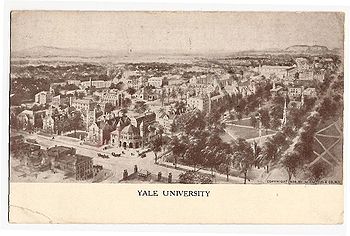
Aerial view from the south, 1906
Expansion caused controversy about Yale's new roles. Noah Porter, moral philosopher, was president from 1871 to 1886. During an age of tremendous expansion in higher education, Porter resisted the rise of the new research university, claiming that an eager embrace of its ideals would corrupt undergraduate education. Many of Porter's contemporaries criticized his administration, and historians since have disparaged his leadership. Levesque (2007) argues Porter was not a simple-minded reactionary, uncritically committed to tradition, but a principled and selective conservative. He did not endorse everything old or reject everything new; rather, he sought to apply long-established ethical and pedagogical principles to a rapidly changing culture. He may have misunderstood some of the challenges of his time, but he correctly anticipated the enduring tensions that have accompanied the emergence and growth of the modern university.
20th century
Behavioral sciences
Behavioral science research was funded and influenced by major foundations. In the 1920s-30s, Rockefeller philanthropies in particular financed behavioral science research projects that promised to fulfill their mandates to 'improve mankind,' mandates that foundation officers transformed into an informal, loosely defined human engineering effort. Controlling behavior, especially sexual and social 'dysfunction,' was a major priority. The behavioral scientists at Yale University, led by President James R. Angell and psychobiologist Robert M. Yerkes, tapped into foundation largesse by crafting research programs that promised to contribute to the 'welfare of mankind' through the investigation and control of sexual and social behavior. Foundation officers supported Yerkess primate research because they accepted his premise that analyzing chimpanzee sexual behavior would yield valuable insights into the evolutionary underpinnings of human development and would thus give investigators the necessary information to ameliorate dysfunction. Between 1925 and 1940, philanthropic foundations contributed approximately seven million dollars to support the Yale Institute of Human Relations and the affiliated Yerkes Laboratories of Primate Biology. Yet, disappointment with the results of the Yale appropriations ultimately contributed to foundation officers turning away from behavioral sciences and toward biological sciences, as they continued their efforts to improve mankind through human engineering. The article examines the interaction between foundation officers and Yale behavioral scientists to illustrate how scientific entrepreneurs successfully crafted rationales about human sexuality to solicit funds, how philanthropic foundation officers became enmeshed in the behavioral science research projects that they funded, and how a cooperative human engineering effort at Yale developed in the 1920s and unraveled in the 1930s.
Biology
Slack (2003) compares three groups that conducted biological research at Yale during overlapping periods between 1910 and 1970. Yale proved important as a site for this research. The leaders of these groups were Ross Granville Harrison, Grace E. Pickford, and G. Evelyn Hutchinson, and their members included both graduate students and more experienced scientists. All produced innovative research, including the opening of new subfields in embryology, endocrinology, and ecology, respectively, over a long period of time. Harrison's group is shown to have been a classic research school; Pickford's and Hutchinson's were not. Pickford's group was successful in spite of her lack of departmental or institutional position or power. Hutchinson and his graduate and postgraduate students were extremely productive, but in diverse areas of ecology rather than one focused area of research or the use of one set of research tools. Hutchinson's example shows that new models for research groups are needed, especially for those that include extensive field research.
Medicine
Milton C. Winternitz led Yale Medical School as its dean from 1920 to 1935. An innovative, even maverick, leader, he not only kept the school from going under but also turned it into a first-class research institution. Dedicated to the new scientific medicine established in Germany, he was equally fervent about 'social medicine' and the study of humans in their culture and environment. He established the 'Yale System' of teaching, with few lectures and fewer exams, and strengthened the full-time faculty system; he also created the graduate-level Yale School of Nursing and the Psychiatry Department, built numerous new buildings, and accomplished much more. Progress toward his plans for an Institute of Human Relations, envisioned as a refuge where social scientists would collaborate with biological scientists in a holistic study of humankind, unfortunately lasted for only a few years before the opposition of resentful anti-Semitic colleagues drove him to resign.
Faculty
Before World War II, most elite university faculties counted among their numbers few, if any, Jews, blacks, women, or other minorities; Yale was no exception. By 1980, this condition had been altered dramatically, as numerous members of those groups held faculty positions.
History and American Studies
The American studies program reflected the worldwide anti-Communist ideological struggle. Norman Holmes Pearson, who worked for the Office of Strategic Studies in London during World War II, returned to Yale and headed the new American studies program, in which scholarship quickly became an instrument of promoting liberty. Popular among undergraduates, the program sought to instruct them in the fundamentals of American civilization and thereby instill a sense of nationalism and national purpose. Also during the 1940s and 1950s, Wyoming millionaire William R. Coe made large contributions to the American studies programs at Yale University and at the University of Wyoming. Coe was concerned to celebrate the 'values' of the Western United States in order to meet the 'threat of communism.'
Women
In 1966, Yale initiated discussions with its sister school Vassar College concerning the possibility of a merger as an effective means to achieve coeducation. However, Vassar, once an all female college, declined Yale's invitation and, ultimately, both Yale and Vassar decided to remain separate and introduce coeducation independently in 1969. Amy Solomon was the first woman to register as a Yale undergraduate; she was also the first woman at Yale to join an undergraduate society, St. Anthony Hall. (Women studied at Yale University as early as 1876, but in graduate-level programs at the Yale Graduate School of Arts and Sciences.)
Class
Yale, like other Ivy League schools, instituted policies in the early twentieth century designed artificially to increase the proportion of white Protestants of notable families in the student body (see numerus clausus), and was one of the last of the Ivies to eliminate such preferences, beginning with the class of 1970.
Town-gown relations
Yale used to have a combative relationship with its home city, but since Richard Levin became president of the University, the University has financially supported many of New Haven's efforts to reinvigorate the city, believing that town and gown relationships are mutually beneficial. Incremental evidence suggests that both the city and the University have benefitted much from this agreement. Yale's relationship with the city is an example where the economic power of the university increased dramatically due to the financial success of the university and a severe decline in the local economy.
Yale in the 21st century
Yale President Rick Levin characterized Yale's institutional priorities: "First, among the nation's finest research universities, Yale is distinctively committed to excellence in undergraduate education. Second, in our graduate and professional schools, as well as in Yale College, we are committed to the education of leaders."
The Boston Globe wrote that "if there's one school that can lay claim to educating the nation's top national leaders over the past three decades, it's Yale." Yale alumni were represented on the Democratic or Republican ticket in every U.S. Presidential election between 1972 and 2004. Yale-educated Presidents since the end of the Vietnam War include Gerald Ford, George H.W. Bush, Bill Clinton, and George W. Bush, and major-party nominees during this period include John Kerry (2004), Joseph Lieberman (Vice President, 2000), and Sargent Shriver (Vice President, 1972). Other Yale alumni who made serious bids for the Presidency during this period include Hillary Rodham Clinton (2008), Howard Dean (2004), Gary Hart (1984 and 1988), Paul Tsongas (1992), Pat Robertson (1988) and Jerry Brown (1976, 1980, 1992).
Several explanations have been offered for Yale’s representation in national elections since the end of the Vietnam War. Various sources note the spirit of campus activism that has existed at Yale since the 1960s, and the intellectual influence of Reverend William Sloane Coffin on many of the future candidates. Yale President Richard Levin attributes the run to Yale’s focus on creating "a laboratory for future leaders," an institutional priority that began during the tenure of Yale Presidents Alfred Whitney Griswold and Kingman Brewster. Richard H. Brodhead, former dean of Yale College and now president of Duke University, stated: "We do give very significant attention to orientation to the community in our admissions, and there is a very strong tradition of volunteerism at Yale." Yale historian Gaddis Smith notes "an ethos of organized activity" at Yale during the 20th century that led John Kerry to lead the Yale Political Union's Liberal Party, George Pataki the Conservative Party, and Joseph Lieberman to manage the Yale Daily News. Camille Paglia points to a history of networking and elitism: "It has to do with a web of friendships and affiliations built up in school." CNN suggests that George W. Bush benefited from preferential admissions policies for the "son and grandson of alumni," and for a "member of a politically influential family." New York Times correspondent Elisabeth Bumiller and The Atlantic Monthly correspondent James Fallows credit the culture of community and cooperation that exists between students, faculty, and administration, which downplays self-interest and reinforces commitment to others.
During the 1988 presidential election, George H. W. Bush (Yale '48) derided Michael Dukakis for having "foreign-policy views born in Harvard Yard's boutique." When challenged on the distinction between Dukakis's Harvard connection and his own Yale background, he said that, unlike Harvard, Yale's reputation was "so diffuse, there isn't a symbol, I don't think, in the Yale situation, any symbolism in it" and said Yale did not share Harvard's reputation for "liberalism and elitism" In 2004, Howard Dean stated, "In some ways, I consider myself separate from the other three (Yale) candidates of 2004. Yale changed so much between the class of '68 and the class of '71. My class was the first class to have women in it; it was the first class to have a significant effort to recruit African Americans. It was an extraordinary time, and in that span of time is the change of an entire generation."
Former British Prime Minister Tony Blair has recently named Yale as the headquarters of his United States Faith and Globalization Initiative, together with Durham University in the UK and National University of Singapore in Asia, to deliver an exclusive program in partnership with Tony Blair Faith Foundation. Former Mexican President Ernesto Zedillo is the Director of the Yale Center for the Study of Globalization and teaches an undergraduate seminar entitled "Debating Globalization". Former presidential candidate and DNC chair Howard Dean teaches a residential college seminar entitled "Understanding Politics and Politicians."
Administration and organization
Main article: List of Yale University people#Heads of Collegiate School.2C Yale College.2C and Yale University
The Yale Provost's Office has launched several women into prominent university presidencies. In 1977, Hanna Holborn Gray was appointed acting President of Yale from this position, and went on to become President of the University of Chicago, the first woman to be full president of a major university. In 1994, Yale Provost Judith Rodin became the first female president of an Ivy League institution at the University of Pennsylvania. In 2002, Provost Alison Richard became the Vice Chancellor of the University of Cambridge. In 2004, Provost Susan Hockfield became the President of the Massachusetts Institute of Technology. In 2007, Deputy Provost Kim Bottomly was named President of Wellesley College.
In 2008, Provost Andrew Hamilton was confirmed to be the Vice Chancellor of the University of Oxford. Former Dean of Yale College Richard H. Brodhead serves as the President of Duke University.
Staff and labor unions
Much of Yale University's staff, including most maintenance staff, dining hall employees, and administrative staff, are unionized. Yale has a history of difficult and prolonged labor negotiations, often culminating in strikes. There have been at least eight strikes since 1968, and The New York Times wrote that Yale has a reputation as having the worst record of labor tension of any university in the U.S. Yale's unusually large endowment further exacerbates the tension over wages. Yale has been accused of failing to treat workers with respect, in addition to the usual concerns over wages. In a 2003 strike, however, more union employees were working than striking. There are currently at least three unions of Yale employees.
校园
Yale's central campus in downtown New Haven covers 260 acres (1.1 km). An additional 500 acres (2 km²) includes the Yale golf course and nature preserves in rural Connecticut and Horse Island.

Yale's Old Campus, April 2009, built in the Neo Gothic style
Yale is noted for its largely Collegiate Gothic campus as well as for several iconic modern buildings commonly discussed in architectural history survey courses: Louis Kahn's Yale Art Gallery and Center for British Art, Eero Saarinen's Ingalls Rink and Ezra Stiles and Morse Colleges, and Paul Rudolph's Art & Architecture Building. Yale also owns and has restored many noteworthy 19th-century mansions along Hillhouse Avenue, which was considered the most beautiful street in America by Charles Dickens when he visited the United States in the 1840s.
Many of Yale's buildings were constructed in the neo-Gothic architecture style from 1917 to 1931. Stone sculpture built into the walls of the buildings portray contemporary college personalities such as a writer, an athlete, a tea-drinking socialite, and a student who has fallen asleep while reading. Similarly, the decorative friezes on the buildings depict contemporary scenes such as policemen chasing a robber and arresting a prostitute (on the wall of the Law School), or a student relaxing with a mug of beer and a cigarette. The architect, James Gamble Rogers, faux-aged these buildings by splashing the walls with acid, deliberately breaking their leaded glass windows and repairing them in the style of the Middle Ages, and creating niches for decorative statuary but leaving them empty to simulate loss or theft over the ages. In fact, the buildings merely simulate Middle Ages architecture, for though they appear to be constructed of solid stone blocks in the authentic manner, most actually have steel framing as was commonly used in 1930. One exception is Harkness Tower, 216 feet (66 m) tall, which was originally a free-standing stone structure. It was reinforced in 1964 to allow the installation of the Yale Memorial Carillon.
File:Old Campus-1909.JPG
The Old Campus ca. 1909
Other examples of the Gothic (also called neo-Gothic and collegiate Gothic) style are on Old Campus by such architects as Henry Austin, Charles C. Haight and Russell Sturgis. Several are associated with members of the Vanderbilt family, including Vanderbilt Hall, Phelps Hall, St. Anthony Hall (a commission for member Frederick William Vanderbilt), the Mason, Sloane and Osborn laboratories, dormitories for the Sheffield Scientific School (the engineering and sciences school at Yale until 1956) and elements of Silliman College, the largest residential college.
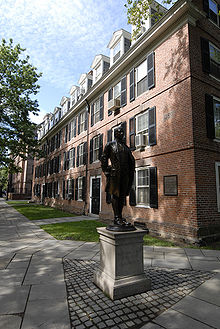
Statue of Nathan Hale in front of Connecticut Hall
The oldest building on campus, Connecticut Hall (built in 1750), is in the Georgian style. Georgian-style buildings erected from 1929 to 1933 include Timothy Dwight College, Pierson College, and Davenport College, except the latter's east, York Street façade, which was constructed in the Gothic style.
The Beinecke Rare Book and Manuscript Library, designed by Gordon Bunshaft of Skidmore, Owings, and Merrill, is one of the largest buildings in the world reserved exclusively for the preservation of rare books and manuscripts. It is located near the center of the University in Hewitt Quadrangle, which is now more commonly referred to as "Beinecke Plaza."
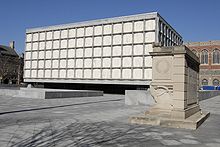
The Beinecke Rare Book Library of Yale University
The library's six-story above-ground tower of book stacks is surrounded by a windowless rectangular building with walls made of translucent Vermont marble, which transmit subdued lighting to the interior and provide protection from direct light, while glowing from within after dark.
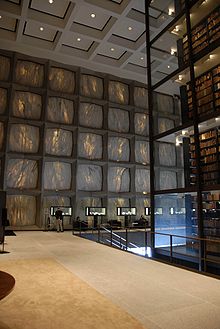
Interior of Beinecke Library
The sculptures in the sunken courtyard by Isamu Noguchi are said to represent time (the pyramid), the sun (the circle), and chance (the cube).
Alumnus Eero Saarinen, Finnish-American architect of such notable structures as the Gateway Arch in St. Louis, Washington Dulles International Airport main terminal, and the CBS Building in Manhattan, designed Ingalls Rink at Yale and the newest residential colleges of Ezra Stiles and Morse. These latter were modelled after the medieval Italian hilltown of San Gimignano — a prototype chosen for the town's pedestrian-friendly milieu and fortress-like stone towers. These tower forms at Yale act in counterpoint to the college's many Gothic spires and Georgian cupolas.
Yale's Office of Sustainability develops and implements sustainability practices at Yale. Yale is committed to reduce its greenhouse gas emissions 10% below 1990 levels by the year 2020. As part of this commitment, the university allocates renewable energy credits to offset some of the energy used by residential colleges. Eleven campus buildings are candidates for LEED design and certification. The Yale Sustainable Food Project initiated the introduction of local, organic vegetables, fruits, and beef to all residential college dining halls. Yale was listed as a Campus Sustainability Leader on the Sustainable Endowments Institute’s College Sustainability Report Card 2008, and received a “B+” grade overall.
- Grove Street Cemetery, New Haven
- Marsh Botanical Garden
- Yale Sustainable Food Project Farm
Notable nonresidential campus buildings
Notable nonresidential campus buildings and landmarks include Battell Chapel, Beinecke Rare Book Library, Harkness Tower, Ingalls Rink, Kline Biology Tower, Osborne Memorial Laboratories, Payne Whitney Gymnasium, Peabody Museum of Natural History, Sterling Hall of Medicine, Sterling Law Buildings, Sterling Memorial Library, Woolsey Hall, Yale Center for British Art, Yale University Art Gallery, and Yale Art & Architecture Building.
Yale's secret society buildings (some of which are called "tombs") were built both to be private yet unmistakeable. A diversity of architectural styles is represented: Berzelius, Don Barber in an austere cube with classical detailing (erected in 1908 or 1910); Book and Snake, Louis R. Metcalfe in a Greek Ionic style (erected in 1901); Elihu, architect unknown but built in a Colonial style (constructed on an early 17th century foundation although the building is from 18th century); Mace and Chain, in a late colonial, early Victorian style (built in 1823). Interior moulding is said to have belonged to Benedict Arnold; Manuscript Society, King Lui-Wu with Dan Kniley responsible for landscaping and Josef Albers for the brickwork intaglio mural. Building constructed in a mid-century modern style; Scroll and Key, Richard Morris Hunt in a Moorish- or Islamic-inspired Beaux-Arts style (erected 1869–70); Skull and Bones, possibly Alexander Jackson Davis or Henry Austin in an Egypto-Doric style utilizing Brownstone (in 1856 the first wing was completed, in 1903 the second wing, 1911 the Neo-Gothic towers in rear garden were completed); St. Elmo, (former tomb) Kenneth M. Murchison, 1912, designs inspired by Elizabethan manor. Current location, brick colonial; and Wolf's Head, Bertram Grosvenor Goodhue (erected 1923-4).
Campus safety
In addition to the Yale University Police Department, founded in 1894, a variety of safety services are available including blue phones, a safety escort, and a shuttle service.
In the 1970s and 1980s, poverty and violent crime rose in New Haven, dampening Yale's student and faculty recruiting efforts. Between 1990 and 2006, New Haven's crime rate fell by half, helped by a community policing strategy by the New Haven police and Yale's campus became the safest among the Ivy League and other peer schools. In 2002–04, Yale reported 14 violent crimes (homicide, aggravated assault, or sex offenses), when Harvard reported 83 such incidents, Princeton 24, and Stanford 54. The incidence of nonviolent crime (burglary, arson, and motor vehicle theft) was also lower than most of its peer schools.
In 2004, a national non-profit watchdog group called Security on Campus filed a complaint with the Department of Education, accusing Yale of under-reporting rape and sexual assaults.
Murders or attempted murders involving Yale students or faculty include:
- In 1974, Yale junior Gary Stein was killed in a robbery. Melvin Jones was convicted in the case and spent fifteen years in prison.
- In 1991, Christian Prince, a sophomore and fourth-generation Yale alumnus, was killed during a robbery committed by 16-year-old James Duncan Fleming. Fleming received a nine-year prison sentence.
- On June 24, 1993, computer science professor David Gelernter was seriously injured in his office in Arthur K. Watson Hall by a bomb sent by serial killer Ted Kaczynski ("The Unabomber").
- In 1998, student Suzanne Jovin was stabbed to death in a wealthy neighborhood 2 miles (3.2 km) from the central campus. Allegations that her thesis advisor was a suspect led to the end of his career at Yale, but the crime remains unsolved.
- In 2009, Annie Le, a pharmacology graduate student was found dead in a Yale laboratory building.
The Yale Campus has been the site of three bombing incidents. In addition to that carried out by the Unabomber, mentioned above, on May Day in 1970, during the New Haven Black Panther trials, two bombs were set off in the basement of Ingalls Rink. No injuries resulted, and the perpetrators were never identified.
On May 21, 2003, an explosive device went off at the Yale Law School, damaging two classrooms. The latter crime has not been solved, and no motive has been discerned; the bombing occurred while the nation was under an elevated terror alert, and while the university was involved in difficult labor negotiations. The homes of at least two former employees were searched, but no arrests have been made in the case.
学术
|
|
This article is missing information about Rankings, carnegie classifications, accreditation, enrollment distributions, academic calendars, academic honors, tuition and fees. This concern has been noted on the talk page where it may be discussed whether or not to include such information. (May 2009) |
|
|
University rankings (overall)
|
|
| ARWU World |
11 |
| ARWU North & Latin America |
9 |
| Forbes |
9 |
| Times Higher Education |
3 |
| USNWR National University |
3 |
| WM National University |
23 |
Admissions
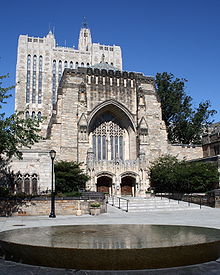
Yale University's Sterling Memorial Library, as seen from Maya Lin's sculpture,
Women's Table. The sculpture records the number of women enrolled at Yale over its history; female undergraduates were not admitted until 1969.
For the Class of 2013, Yale accepted 1,951 students out of 26,000 total applications, hitting a University record-low acceptance of 7.5%. Yale accepted 742 out of 5,556 early applicants and 1,209 out of 20,444 regular applicants.
Yale College offers need-blind admissions and need-based financial aid to all applicants, including international applicants. Yale commits to meet the full demonstrated financial need of all applicants, and more than 40% of Yale students receive financial assistance. Most financial aid is in the form of grants and scholarships that do not need to be paid back to the University, and the average scholarship for the 2006–2007 school year was $26,900.
Half of all Yale undergraduates are women, more than 30% are minorities, and 8% are international students. 55% attended public schools and 45% attended independent, religious, or international schools. In addition, Yale College admits a small group of nontraditional students each year, through the Eli Whitney Students Program.
Collections
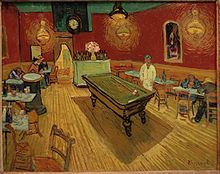
The Night Café, Vincent van Gogh, 1888, Yale Art Gallery.
Yale University Library, which holds over 12 million volumes, is the second-largest university collection in the United States. The main library, Sterling Memorial Library, contains about four million volumes, and other holdings are dispersed at subject libraries.
Rare books are found in a number of Yale collections. The Beinecke Rare Book Library has a large collection of rare books and manuscripts. The Harvey Cushing/John Hay Whitney Medical Library includes important historical medical texts, including an impressive collection of rare books, as well as historical medical instruments. The Lewis Walpole Library contains the largest collection of 18th-century British literary works. The Elizabethan Club, technically a private organization, makes its Elizabethan folios and first editions available to qualified researchers through Yale.
Yale's museum collections are also of international stature. The Yale University Art Gallery is the country's first university-affiliated art museum. It contains more than 180,000 works, including old masters and important collections of modern art, in the Swartout and Kahn buildings. The latter, Louis Kahn's first large-scale American work (1953), was renovated and reopened in December 2006. The Yale Center for British Art, the largest collection of British art outside of the UK, grew from a gift of Paul Mellon and is housed in another Kahn-designed building.
The Peabody Museum of Natural History is New Haven's most popular museum, well-used by school children as well as containing research collections in anthropology, archaeology, and the natural environment. The Yale University Collection of Musical Instruments, affiliated with the Yale School of Music, is perhaps the least well-known of Yale's collections, because its hours of opening are restricted.
The museums also house the artifacts brought to the United States from Peru by Yale history professor Hiram Bingham in his expedition to Machu Picchu in 1912 - when the removal of such artifacts was legal. Peru would now like to have the items returned; Yale has so far declined.
Faculty, research, and intellectual traditions
|
|
This article is missing information about research expenditures, government support, physical research plant, notable faculty, notable research programs or groups. This concern has been noted on the talk page where it may be discussed whether or not to include such information. (May 2009) |
The college is, after normalization for institution size, the tenth-largest baccalaureate source of doctoral degree recipients in the United States, and the largest such source within the Ivy League.
Yale's English and Comparative Literature departments were part of the New Criticism movement. Of the New Critics, Robert Penn Warren, W.K. Wimsatt, and Cleanth Brooks were all Yale faculty. Later, the Yale Comparative literature department became a center of American deconstruction. Jacques Derrida, the father of deconstruction, taught at the Department of Comparative Literature from the late seventies to mid-1980s. Several other Yale faculty members were also associated with deconstruction, forming the so-called "Yale School". These included Paul de Man who taught in the Departments of Comparative Literature and French, J. Hillis Miller, Geoffrey Hartman (both taught in the Departments of English and Comparative Literature), and Harold Bloom (English), whose theoretical position was always somewhat specific, and who ultimately took a very different path from the rest of this group. Yale's history department has also originated important intellectual trends. Historian C. Vann Woodward is credited for beginning in the 1960s an important stream of southern historians; likewise, David Montgomery, a labor historian, advised many of the current generation of labor historians in the country. Yale's Music School and Department fostered the growth of Music Theory in the latter half of the twentieth century. The Journal of Music Theory was founded there in 1957; Allen Forte and David Lewin were influential teachers and scholars, however the latter is more often affiliated with Harvard University.
Campus life
Yale is a medium-sized research university, most of whose students are in the graduate and professional schools. Undergraduates, or Yale College students, come from a variety of ethnic, national, and socio-economic backgrounds. Of the 2006-07 freshman class, 9% are non-U.S. citizens, while 54% went to public high schools. Yale is also an open campus for the gay community. Its active LGBT community first received wide publicity in the late 1980s, when Yale obtained a reputation as the "gay Ivy," due largely to a 1987 Wall Street Journal article written by Julie V. Iovine, an alumna and the spouse of a Yale faculty member. During the same year, the University hosted a national conference on gay and lesbian studies and established the Lesbian and Gay Studies Center. The slogan "One in Four, Maybe More" was coined by the campus gay community. While the community in the 1980s and early 1990s was very activist, today most LGBT events have become part of the general campus social scene. For example, the annual LGBT Co-op Dance attracts straight as well as gay students.
Residential colleges
Main article: Residential colleges of Yale University
Yale has a system of 12 residential colleges, instituted in 1933 through a grant by Yale graduate Edward S. Harkness, who admired the college systems at Oxford and Cambridge. Each college has a Dean, Master, affiliated faculty, and resident Fellows. Each college also features distinctive architecture, secluded courtyards, a commons room, meeting rooms/classrooms, and a dining hall; in addition some have chapels, libraries, squash courts, pool tables, short order dining counters, cafes, or darkrooms. While each college at Yale offers its own seminars, social events, and Master's Teas, most of them are open to students from other residential colleges.
All of Yale's 2,000 undergraduate courses are open to members of any college.
The dominant architecture of the residential colleges is Neo-Gothic, in line with the characteristic architecture of the university. Several colleges have other period architecture, such as Georgian and Federal, and the two most recent (Morse and Ezra Stiles) have modernist concrete exteriors.
Students are assigned to a residential college for their freshman year. Only two residential colleges house freshmen. The majority of on-campus freshmen live on the "Old Campus", an extensive quadrangle formed by older buildings. Each residential college has its own dining hall, but students are permitted to eat in any residential college dining hall or the large dining facility called "Commons."
Residential colleges are named for important figures or places in university history or notable alumni.
List of residential colleges
|
|
This section is in a list format that may be better presented using prose. You can help by converting this section to prose, if appropriate. Editing help is available. (May 2009) |
This is a list of residential colleges at Yale.
- Berkeley College, named for the Rt. Rev. George Berkeley (1685–1753), early benefactor of Yale.
- Branford College, named for Branford, Connecticut, where Yale was briefly located.
- Calhoun College, named for John C. Calhoun, vice-president and influential member of Congress of the United States.
- Davenport College, named for Rev. John Davenport, the founder of New Haven. Often called "D'port".
- Ezra Stiles College, named for the Rev. Ezra Stiles, a president of Yale. Generally called "Stiles," despite an early-1990s crusade by then-master Traugott Lawler to preserve the use of the full name in everyday speech. Its buildings were designed by Eero Saarinen.
- Jonathan Edwards College, named for theologian, Yale alumnus, and Princeton co-founder Jonathan Edwards. Generally called "J.E." The oldest of the residential colleges, J.E. is the only college with an independent endowment, the Jonathan Edwards Trust.
- Morse College, named for Samuel F. B. Morse, inventor of Morse code and the telegraph. Also designed by Eero Saarinen.
- Pierson College, named for Yale's first rector, Abraham Pierson.
- Saybrook College, named for Old Saybrook, Connecticut, the town in which Yale was founded.
- Silliman College, named for noted scientist and Yale professor Benjamin Silliman. About half of its structures were originally part of the Sheffield Scientific School.
- Timothy Dwight College, named for the two Yale presidents of that name, Timothy Dwight IV and Timothy Dwight V. Often abbreviated "T.D."
- Trumbull College, named for Jonathan Trumbull, first Governor of Connecticut.
In 1998, Yale launched a series of extensive renovations to the older residential buildings, which in many decades of existence had seen only routine maintenance and incremental improvements to plumbing, heating, and electrical and network wiring. Many of these renovations have now been completed, and among other improvements, renovated colleges feature newly built basement facilities including restaurants, game rooms, theaters, athletic facilities, and music practice rooms.
In June 2008, President Levin announced that the Yale Corporation had authorized the construction of two new residential colleges, scheduled to open in 2013. The additional colleges, to be built in the northern part of the campus, will allow for expanded admission and a reduction of crowding in the existing residential colleges. Designs have been released, and some public controversy has surfaced over Yale's decision to demolish a number of historic buildings on the site, including a recently constructed library, in order to clear it for the $600 million new structures.
Student organizations
Main article: List of Yale University student organizations
The Yale Political Union, the oldest student political organization in the United States, is often the largest organization on campus, and is advised by alumni political leaders such as John Kerry and George Pataki.
The university hosts a variety of student journals, magazines, and newspapers. Yale Journal of Biology and Medicine (YJBM) is such a good example. The latter category includes the Yale Daily News, which was first published in 1878, as well as the weekly Yale Herald, published since 1986. Dwight Hall, an independent, non-profit community service organization, oversees more than 2,000 Yale undergraduates working on more than 70 community service initiatives in New Haven. The Yale College Council runs several agencies that oversee campus wide activities and student services. The Yale Dramatic Association and Bulldog Productions cater to the theater and film communities, respectively. In addition, the Yale Drama Coalition serves to coordinate between and provide resources for the various Sudler Fund sponsored theater productions which run each weekend.
The campus also includes several fraternities and sororities. The campus features at least 18 a cappella groups, the most famous of which is The Whiffenpoofs, who are unusual among college singing groups in being made up solely of senior men.
Yale's secret societies include Skull and Bones, Scroll and Key, Wolf's Head, Book and Snake, Elihu, Berzelius, St. Elmo, Manuscript, and Mace and Chain.
The Elizabethan Club, a social club, has a membership of undergraduates, graduates, faculty and staff with literary or artistic interests. Membership is by invitation. Members and their guests may enter the "Lizzie's" premises for conversation and tea. The club owns first editions of a Shakespeare Folio, several Shakespeare Quartos, a first edition of Milton's Paradise Lost, among other important literary texts.
Traditions
Yale seniors at graduation smash clay pipes underfoot to symbolize passage from their "bright college years." ("Bright College Years," the University's alma mater, was penned in 1881 by Henry Durand, Class of 1881, to the tune of Die Wacht am Rhein.) Yale's student tour guides tell visitors that students consider it good luck to rub the toe of the statue of Theodore Dwight Woolsey on Old Campus. Actual students rarely do so.
体育运动
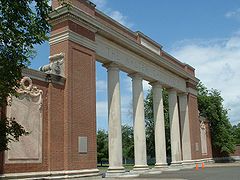
The Walter Camp Gate at the Yale Athletic Complex.
Main article: Yale Bulldogs
Yale supports 35 varsity athletic teams that compete in the Ivy League Conference, the Eastern College Athletic Conference, the New England Intercollegiate Sailing Association. Yale athletic teams compete intercollegiately at the NCAA Division I level. Like other members of the Ivy League, Yale does not offer athletic scholarships.
Yale has numerous athletic facilities, including the Yale Bowl (the nation's first natural "bowl" stadium, and prototype for such stadiums as the Los Angeles Memorial Coliseum and the Rose Bowl), located at The Walter Camp Field athletic complex, and the Payne Whitney Gymnasium, the second-largest indoor athletic complex in the world. October 21, 2000 marked the dedication of Yale's fourth new boathouse in 157 years of collegiate rowing. The Richard Gilder Boathouse is named to honor former Olympic rower Virginia Gilder '79 and her father Richard Gilder '54, who gave $4 million towards the $7.5 million project. Yale also maintains the Gales Ferry site where the heavyweight men's team trains for the prestigious Yale-Harvard Boat Race.
Yale crew is the oldest collegiate athletic team in America, and won Olympic Games Gold Medal for men's eights in 1924 and 1956. The Yale Corinthian Yacht Club, founded in 1881, is the oldest collegiate sailing club in the world.
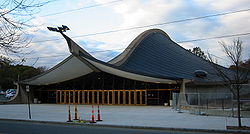
Ingalls Rink by Eero Saarinen, thin-shell and tensile structure
In 1896, Yale and Johns Hopkins played the first known ice hockey game in the United States. Since 2006, the school's ice hockey clubs have played a commemorative game.
For kicks, between 1954 and 1982, residential college teams and student organizations played bladderball.
Yale students claim to have invented Frisbee, by tossing empty Frisbie Pie Company tins.
Song
Notable among the songs commonly played and sung at events such as commencement, convocation, alumni gatherings, and athletic games are the alma mater, "Bright College Years", and the Yale fight song, "Down the Field."
Two other fight songs, "Bulldog, Bulldog" and "Bingo Eli Yale", written by Cole Porter during his undergraduate days, are still sung at football games. Another fight song sung at games is "Boola Boola". According to “College Fight Songs: An Annotated Anthology” published in 1998, “Down the Field” ranks as the fourth-greatest fight song of all time.
Mascot
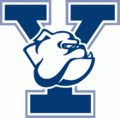
The logo of the Yale Bulldogs.
The school mascot is "Handsome Dan," the known Yale bulldog, and the Yale fight song (written by Cole Porter while he was a student at Yale) contains the refrain, "Bulldog, bulldog, bow wow wow." The school color is Yale Blue. Yale's Handsome Dan is believed to be the first college mascot in America, having been established in 1889.
Yale athletics are supported by the Yale Precision Marching Band. Precision is used here ironically; the band is a scatter-style band that runs wildly between formations rather than actually marching. The band attends every home football game and many away, as well as most hockey and basketball games throughout the winter.
Yale intramural sports are also a significant aspect of student life. Students compete for their respective residential colleges, fostering a friendly rivalry. The year is divided into fall, winter, and spring seasons, each of which includes about ten different sports. About half the sports are coeducational. At the end of the year, the residential college with the most points (not all sports count equally) wins the Tyng Cup.
[edit] Notable people
Benefactors
Yale has had many financial supporters, but some stand out by the magnitude or timeliness of their contributions. Among those who have made large donations commemorated at the university are: Elihu Yale; Jeremiah Dummer; the Harkness family (Edward, Anna, and William); the Beinecke family (Edwin, Frederick, and Walter); John William Sterling; Payne Whitney; Joseph E. Sheffield, Paul Mellon, Charles B. G. Murphy and William K. Lanman. The Yale Class of 1954, led by Richard Gilder, donated $70 million in commemoration of their 50th reunion.
知名校友与教职
|
|
This section does not cite any references or sources.
Please help improve this article by adding citations to reliable sources. Unsourced material may be challenged and removed. (September 2009) |
Main article: List of Yale University people
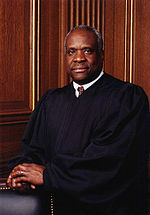
Supreme Court Justice Clarence Thomas, Yale Law School class of 1974
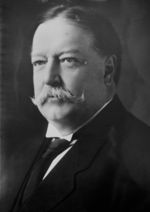
President William Howard Taft, graduated from Yale in 1878.
Yale has produced alumni distinguished in their respective fields. Among the most well known are U.S. Presidents William Howard Taft, Gerald Ford, George H.W. Bush, Bill Clinton and George W. Bush; current Supreme Court Justices Sonia Sotomayor, Samuel Alito and Clarence Thomas; U.S. Secretaries of State Hillary Rodham Clinton and Dean Acheson; Democratic Presidential nominee John Kerry; recent Nobel Laureates Paul Krugman, Edmund Phelps, John Bennett Fenn, Raymond Davis Jr., George Akerlof and Thomas A. Steitz; Pulitzer Prize winners Stephen Vincent Benet, Bob Woodward, John Hersey, Garry Trudeau, David McCullough, and David M. Kennedy; authors Sinclair Lewis, and Tom Wolfe; lexicographer Noah Webster; inventors Samuel F.B. Morse and Eli Whitney; patriot and "first spy" Nathan Hale; theologians Jonathan Edwards and Reinhold Niebuhr; Academy Award winners Paul Newman, Meryl Streep, Douglas Wick, Holly Hunter, and Jodie Foster; "Father of American football" Walter Camp; "Perfect Oarsman" Rusty Wailes; composers Charles Ives and Cole Porter; Morgan Stanley founder Harold Stanley; FedEx founder Frederick W. Smith; academics Benjamin Silliman, Camille Paglia, Harold Bloom, Alan Dershowitz, and Henry Louis Gates Jr.; Peace Corps founder Sargent Shriver; neurosurgeons Ben Carson and Harvey Williams Cushing; child psychologist Benjamin Spock; sculptor Richard Serra; film critic Gene Siskel; popularizer of science Clifford Pickover, popularizer of American literature William Lyon Phelps; architects Maya Lin, Richard Rogers and Norman Foster; television commentators Dick Cavett and Anderson Cooper; pundits William F. Buckley, Jr., David Gergen and Fareed Zakaria; Time Magazine co-founder Henry Luce; former President of Mexico Ernesto Zedillo; former President of the Federal Republic of Germany Karl Carstens; former Philippines President José Paciano Laurel; Attorney General Alphonso Taft father of President William H. Taft; and Theodore Woolsey, Jr., Yale faculty member and forestry expert.
See List of Yale University people for other notable members of the alumni community.
Yale in fiction and popular culture
Further information: List of Yale University people#Fictional and Yale in popular culture
|
|
This "In popular culture" section may contain minor or trivial references. Please reorganize this content to explain the subject's impact on popular culture rather than simply listing appearances, and remove trivial references. (September 2009) |
- Owen Johnson's novel, Stover at Yale, follows the college career of Dink Stover.
- Yale appears in F. Scott Fitzgerald's classic novel The Great Gatsby and indirectly in Tender Is the Night, as well as his short stories "The Curious Case of Benjamin Button" and "Bernice Bobs Her Hair."
- Frank Merriwell, the model for all later juvenile sports fiction, plays football, baseball, crew, and track at Yale while solving mysteries and righting wrongs.
- Mary Mazzio's 1999 documentary film, A Hero for Daisy, chronicles the 1976 demonstration at Yale in which the women's rowing team demanded equal athletic facilities.
- In the show Gilmore Girls, Logan Huntzberger, Rory Gilmore, Richard Gilmore, and Paris Geller all went to Yale. Rory Gilmore and Paris Geller also served as editors of the Yale Daily News.
- Yale is a theme in the TV show Gossip Girl. Blair Waldorf aspires to go to the school which has been her obsession since childhood.
- In Gossip Girl the books Blair Waldorf also has an obsession with attending Yale and names her mother's baby Yale.
- In Beverly Hills, 90210, the character of Andrea Zuckerman goes to Yale.
- In John Grisham's legal-thriller The Associate, protagonist Kyle McAvoy graduates from Yale Law School.
- In the 2006 romantic comedy, It's a Boy Girl Thing, Nell Bedworth has dreamed of going to Yale since she was a little girl. While having switched bodies with star quarterback, Woody Deane, he survives the Yale interview and once switched back, Nell receives her letter of acceptance.
扩展阅读
- Bagg, Lyman H. Four Years at Yale, New Haven, 1891.
- Blum, John Morton. A life with history (2004) 283pp, memoir of history professor and advisor to the president
- Brown, Chandos Michael. Benjamin Silliman: A Life in the Young Republic. (1989). 377 pp.
- Buckley, William F., Jr. God and Man at Yale, 1951.
- Dana, Arnold G. Yale Old and New, 78 vols. personal scrapbook, 1942.
- Deming, Clarence. Yale Yesterdays, New Haven, Yale University Press, 1915.
- Dexter, Franklin Bowditch. Biographical Sketches of Graduates of Yale: Yale College with Annals of the College History, 6 vols. New York, 1885–1912.
- __________. (1901). Documentary History of Yale University: Under the Original Charter of the Collegiate School of Connecticut, 1701–1745. New Haven: Yale University Press
- Fitzmier, John R. New England's Moral Legislator: Timothy Dwight, 1752-1817 (1998). 261 pp.
- French, Robert Dudley. The Memorial Quadrangle, New Haven, Yale University Press, 1929.
- Furniss, Edgar S. The Graduate School of Yale, New Haven, 1965.
- Gilpen, Toni, et al. On Strike For Respect, (updated edition: University of Illinois Press, 1995,)
- Holden, Reuben A. Yale: A Pictorial History, New Haven, Yale University Press, 1967.
- Kabaservice, Geoffrey. The Guardians: Kingman Brewster, His Circle, and the Rise of the Liberal Establishment, (2004). 573 pp.
- Kalman, Laura. Legal Realism at Yale, 1927-1960 (1986). 314pp.
- Kelley, Brooks Mather. Yale: A History. New Haven: Yale University Press, 1999. 10-ISBN 0-300-07843-9: 13-ISBN 978-0-300-07843-5; OCLC 810552
- Kingsley, William L. Yale College. A Sketch of its History, 2 vols. New York, 1879.
- Mendenhall, Thomas C. The Harvard-Yale Boat Race, 1852–1924, and the Coming of Sport to the American College. (1993). 371 pp.
- Nelson, Cary. Will Teach for Food: Academic Labor in Crisis, Minneapolis, University of Minnesota Press, 1997.
- Nissenbaum, Stephen, ed. The Great Awakening at Yale College (1972). 263 pp.
- Oren, Dan A. Joining the Club: A History of Jews and Yale, New Haven, Yale University Press, 1985.* Oviatt, Edwin. The Beginnings of Yale (1701–1726), New Haven, Yale University Press, 1916.
- Pierson, George Wilson. Yale College, An Educational History (1871–1921), New Haven, Yale University Press, 1952.
- __________, The Founding of Yale: The Legend of the Forty Folios, New Haven, Yale University Press, 1988.
- Pinnell, Patrick L. The Campus Guide: Yale University, Princeton Architectural Press, New York, 1999.
- Stevenson, Louise L. Scholarly Means to Evangelical Ends: The New Haven Scholars and the Transformation of Higher Learning in America, 1830-1890 (1986). 221 pp.
- Scully, Vincent et al, eds. Yale in New Haven: Architecture and Urbanism. New Haven: Yale University, 2004.
- Stokes, Anson Phelps. Memorials of Eminent Yale Men, 2 vols. New Haven, Yale University Press, 1914.
- Synnott, Marcia Graham. The Half-Opened Door: Discrimination and Admissions at Harvard, Yale, and Princeton, 1900-1970 (1979). 310 pp.
- Tucker, Louis Leonard. Connecticut's Seminary of Sedition: Yale College. Chester, Conn.: Pequot, 1973. 78 pp.
- Warch, Richard. School of the Prophets: Yale College, 1701-1740. (1973). 339 pp.
- Welch, Lewis Sheldon, and Walter Camp. Yale, her campus, class-rooms, and athletics (1900). online
- Whitehead, John S. The Separation of College and State: Columbia, Dartmouth, Harvard, and Yale, 1776-1876 (1973). 262 pp.
- Wilson, Leonard G., ed. Benjamin Silliman and His Circle: Studies on the Influence of Benjamin Silliman on Science in
America (1979). 228 pp.
- Yale, The University College (1921–1937), New Haven, Yale University Press, 1955.
[edit] Secret societies
- Robbins, Alexandra, Secrets of the Tomb: Skull and Bones, the Ivy League, and the Hidden Paths of Power, Little Brown & Co., 2002; ISBN 0-316-73561-2 (paper edition).
- Millegan, Kris (ed.), Fleshing Out Skull & Bones, TrineDay, 2003. ISBN 0-9752906-0-6 (paper edition).
Notes and references
- ^ Hechinger, John (September 11, 2009). "Harvard, Yale Are Big Losers in 'The Game' of Investing". The Wall Street Journal: p. A4. http://online.wsj.com/article/SB125261209050800581.html#mod=todays_us_page_one. Retrieved September 11, 2009.
- ^ "Yale Facts | Yale". Yale.edu. http://www.yale.edu/about/facts.html. Retrieved 2009-09-16.
- ^ "Listen, Elis'![sic] Hear You Not These Joyful Sounds? Songs of Victors at the Revere. Over Three Hundred Cheer for Harvard." The Boston Daily Globe, December 9, 1890, p. 7. (Story about a Revere House celebration of a Harvard football victory over Yale).
- ^ Fitzgerald, F. Scott (1920), This Side of Paradise, chapter 2: "half-a-dozen seats were kept from sale and occupied by six of the worst-looking vagabonds that could be hired from the streets... At the moment in the show where Firebrand, the Pirate Chief, pointed at his black flag and said, "I am a Yale graduate — note my Skull and Bones!" — at this very moment the six vagabonds were instructed to rise conspicuously and leave the theatre with looks of deep melancholy and an injured dignity. It was claimed though never proved that on one occasion the hired Elis were swelled by one of the real thing."
- ^ Kanya Balakrishna (November 20, 2006). "Five Elis win Rhodes". Yale Daily News. http://www.yaledailynews.com/Article.aspx?ArticleID=34429. Retrieved 2006-12-31. , "Four Yale undergraduates and one student from the Graduate School are among the 32 students around the country to receive Rhodes scholarships this year.
- ^ Mark Alden Branch (February 2003). "The Ten Greatest Yalies Who Never Were". Yale Alumni Magazine. http://www.yalealumnimagazine.com/issues/03_02/fictional.html. Retrieved 2006-02-26.
- ^ "Academic programs | Yale". Yale.edu. http://www.yale.edu/schools/index.html. Retrieved 2009-09-16.
- ^ YaleDailyNews.com
- ^ Yale.edu
- ^ YaleDailyNews.com
- ^ "Yale University Library: Libraries & Collections A-Z". Library.yale.edu. 2006-07-10. http://www.library.yale.edu/libraries/libraries.html. Retrieved 2009-09-16.
- ^ The Harvard Crimson: "I'm Gonna Git Yoy Sukka: Classic Stories of Revenge at Harvard.". Retrieved April 10, 2007.
- ^ Although Pierson was "rector" in his own time, he is today considered the first president of Yale.
- ^ "Increase Mather". http://college.hmco.com/history/readerscomp/rcah/html/ah_057300_matherincrea.htm. , Encyclopædia Britannica Eleventh Edition, Encyclopedia Britannica
- ^ Louis Leonard Tucker, Puritan Protagonist: President Thomas Clap of Yale College (1970); Edmund S. Morgan, The Gentle Puritan: A Life of Ezra Stiles, 1727-1795 (1970).
- ^ "Edmund Fanning (1739-1818)". http://freepages.genealogy.rootsweb.ancestry.com/~jwickham/edmund.htm. Retrieved 2009-06-30.
- ^ Historian Bruce Daniels has used biographical dictionaries of the college graduates of Yale University, presents statistics on Yale graduates from the classes of 1702 to 1780, focusing on the graduates' career choices, their success in life, religious affiliation, vital statistics, the percentage of those who supported the American Revolution, and geographic mobility. See Bruce C. Daniels, "College Students and Puritan Society: a Quantitative Profile of Yale Graduates in Colonial America," Connecticut History 1982 (23): 1-23
- ^ Kathryn McDaniel. Moore, "The War with the Tutors: Student-faculty Conflict at Harvard and Yale, 1745-1771," History of Education Quarterly 1978 18(2): 115-127,
- ^ None of these continue to exist today. They are commemorated in names given to campus structures, such as Brothers in Unity Courtyard in Branford College.
- ^ Michael S. Pak, "The Yale Report of 1828: A New Reading and New Implications," History of Education Quarterly 2008 48(1): 30-57; Melvin I. Urofsky, "Reforms and Response: The Yale Report of 1828," History of Education Quarterly, Vol. 5, No. 1 (Mar., 1965), pp. 53-67 in JSTOR
- ^ Louise L. Stevenson, Scholarly Means to Evangelical Ends: The New Haven Scholars and the Transformation of Higher Learning in America, 1830-1890 (1986)
- ^ Alfred McClung Lee, "The Forgotten Sumner," Journal of the History of Sociology 1980-1981 3(1): 87-106
- ^ Robert Higgs, "'Götterdämmerung' and Palingenesis: Yale and the Heroic Ideal, 1865-1914," Proteus 1986 3(1): 18-24
- ^ Ronald A. Smith, Sports and Freedom: The Rise of Big Time College Athletics (1988)
- ^ Roberta J. Park, "Muscle, Mind, and 'Agon:' Intercollegiate Debating and Athletics at Harvard and Yale, 1892-1909," Journal of Sport History 1987 14(3): 263-285
- ^ John S., Watterson III, "The Football Crisis of 1909-1910: the Response of the Eastern 'Big Three'," Journal of Sport History 1981 8(1): 33-49
- ^ Sheffield was originally named Yale Scientific School; it was renamed in 1861 after a major donation from Joseph E. Sheffield.
- ^ George Levesque, "Noah Porter Revisited," Perspectives on the History of Higher Education 2007 26: 29-66,
- ^ Kersten Jacobson Biehn, "Psychobiology, Sex Research and Chimpanzees: Philanthropic Foundation Support for the Behavioral Sciences at Yale University, 1923-41," History of the Human Sciences 2008 21(2): 21-43,
- ^ Nancy G. Slack, "Are Research Schools Necessary? Contrasting Models of 20th Century Research at Yale Led by Ross Granville Harrison, Grace E. Pickford and G. Evelyn Hutchinson," Journal of the History of Biology 2003 36(3): 501-529,
- ^ Howard Spiro and Priscilla Waters Norton, "Dean Milton C. Winternitz at Yale," Perspectives in Biology & Medicine 2003 46(3): 403-412,
- ^ William Palmer, "On or about 1950 or 1955 History Departments Changed: A Step in the Creation of the Modern History Department," Journal of the Historical Society (1529921x); 2007 7(3): 385-405
- ^ Michael Holzman, "The Ideological Origins of American Studies at Yale," American Studies 40:2 (Summer 1999): 71-99
- ^ Liza Nicholas, "Wyoming as America: Celebrations, a Museum, and Yale," American Quarterly, Vol. 54, No. 3 (Sep., 2002), pp. 437-465 in JSTOR
- ^ A History of the Curriculum 1865-1970s - Vassar College Encyclopedia
- ^ Yale Bulletin and Calendar: "Transformations brought about by Yale women.". Retrieved April 10, 2007.
- ^ Yale Alumni Magazine: "The Birth of a New Institution.". Retrieved April 10, 2007.
- ^ Gordon Lafer, "Land and Labor in the Post-Industrial University Town: Remaking Social Geography," Political Geography 2003 22(1): 89-117, focuses on Yale.
- ^ "Preparing for Yale's Fourth Century". Yale Alumni Magazine. http://www.yalealumnimagazine.com/issues/96_12/levin.html. Retrieved April 10, 2007.
- ^ Boston Globe 17 November 2002, Magazine, p. 6
- ^ Los Angeles Times 4 October 2000, p. E1
- ^ New York Times: 14, 13 August 2000
- ^ Boston Globe: F1, 13 August 2000
- ^ Kinsley, Michael (January 20, 2003). "How affirmative action helped George W.". http://www.cnn.com/2003/ALLPOLITICS/01/20/timep.affirm.action.tm/.
- ^ Yale Alumni Magazine: 45. May/June 2004.
- ^ Tarpley, Webster G.; Chaitkin, Anton. "George Bush: The Unauthorized Biography: Chapter XXII Bush Takes The Presidency". Webster G. Tarpley. http://www.tarpley.net/bush22.htm. Retrieved 2006-12-17.
- ^ Dowd, Maureen (June 11, 1998). "Bush Traces How Yale Differs From Harvard". The New York Times: p. 10.
- ^ "For Country: The (Second) Great All-Blue Presidential Race". Yale Alumni Magazine. http://www.yalealumnimagazine.com/issues/2004_05/presidents.html. Retrieved April 9, 2007.
- ^ "Seeking to Understand Faith and Globalisation". The Tony Blair Faith Foundation. http://www.tonyblairfaithfoundation.org/projects/faith-and-globalisation/. Retrieved 2009-09-16.
- ^ Yale Daily News: "Bottomly to Leave for Wellesley Presidency."
- ^ Yale's Labor Troubles Deepen as Thousands Go on Strike - New York Times
- ^ Solidarity Strong as Yale Strike Ends
- ^ Office of Public Affairs at Yale - News Release
- ^ YaleUnions.org
- ^ Yale University: "A Framework for Campus Planning.". Retrieved April 9, 2007.
- ^ Assorted pictures of Yale's campus.. Retrieved April 10, 2007.
- ^ About the Yale Art Gallery., Retrieved April 10, 2007.
- ^ Yale Herald: "Donor steps up to fund CCL renovations.". Retrieved April 10, 2007.
- ^ Vanderbilt Hall
- ^ Phelps Hall
- ^ Silliman College
- ^ Beinecke Rare Book Library: "About the Library Building.". Retrieved April 10, 2007.
- ^ Assorted pictures of Ezra Stiles College, Retrieved April 10, 2007.
- ^ "Yale Sustainability Strategy". Yale University. http://www.yale.edu/sustainability/strategy.htm. Retrieved 2008-06-03.
- ^ ""Yale commits to long-term Greenhouse Gas Reduction and Renewable Energy Strategy"". Yale University. http://www.yale.edu/sustainability/yaleCommits.htm. Retrieved 2008-06-03.
- ^ "“Yale’s Greenhouse Gas Reduction Strategy”". Yale University. http://64.233.169.104/search?q=cache:9V9KQM2ibk4J:www.yale.edu/environ/docs/greenhouse_fin1.pdf+yale+LEED+eleven&hl=en&ct=clnk&cd=1&gl=us&client=firefox-a. Retrieved 2008-06-03.
- ^ "Yale Sustainable Food Project". Yale University. http://www.yale.edu/sustainablefood/. Retrieved 2008-06-03.
- ^ "College Sustainability Report Card 2008". Sustainable Endowments Institute. http://www.endowmentinstitute.org/. Retrieved 2008-06-03.
- ^ "Yale University Police Department". http://www.yale.edu/police/. Retrieved 2010-01-05.
- ^ "Yale University Department of Security". http://www.yalesecurity.yale.edu/services.html. Retrieved 2010-01-05.
- ^ AJ Giannini. Life, love, death and prestige in New Haven. Neon. 27:113-116, 1984.
- ^ Office of Post-Secondary Education: "Security search.", Retrieved April 9, 2007.
- ^ Yale Daily News: "Panel questions way University handles sex crimes", Retrieved April 9, 2007.
- ^ Yale Daily News: " Yale may not report all crimes", Retrieved April 9, 2007.
- ^ Shanghai Jiao Tong University (2009). "Academic Ranking of World Universities". Institute of Higher Education, Shanghai Jiao Tong University. http://www.arwu.org/ARWU2009.jsp. Retrieved 2009-12-23.
- ^ Shanghai Jiao Tong University (2009). "Ranking of North & Latin American Universities". Institute of Higher Education, Shanghai Jiao Tong University. http://www.arwu.org/Americas2009.jsp. Retrieved 2009-12-23.
- ^ "America's Best Colleges". Forbes. 2009. http://www.forbes.com/lists/2009/94/colleges-09_Americas-Best-Colleges_Rank.html. Retrieved 2009-09-13.
- ^ The Times (2009). "World University Rankings". The Times Higher Educational Supplement. http://www.topuniversities.com/university-rankings/world-university-rankings/2009/results. Retrieved 2010-02-09.
- ^ "National Universities Rankings". America's Best Colleges 2009. U.S. News & World Report. 2009. http://colleges.usnews.rankingsandreviews.com/college/national-search. Retrieved 2009-05-18.
- ^ "The Washington Monthly National University Rankings" (PDF). The Washington Monthly. 2009. http://www.washingtonmonthly.com/college_guide/rankings/national_university_rank.php. Retrieved 2009-12-23.
- ^ "America's Best Colleges 2007". http://www.usnews.com/usnews/edu/college/rankings/brief/t1natudoc_brief.php. Retrieved 2007-03-20.
- ^ YaleDailyNews.com
- ^ Yale Daily News: "Diverse class of 2010 arrives in Elm City.". Retrieved April 9, 2007.
- ^ "ALA Library Fact Sheet Number 22 - The Nation's Largest Libraries". American Library Association. http://www.ala.org/ala/alalibrary/libraryfactsheet/alalibraryfactsheet22.cfm. Retrieved 2008-02-19.
- ^ Machu Picchu in a Box
- ^ Centre.edu "Baccalaureate Origins Peer Analysis 2000, Center College."
- ^ Yale Factsheet
- ^ Editors, The (July/August 2009), "Why they call Yale the "Gay Ivy"", Yale Alumni Magazine: 33
- ^ Chauncey, George (July/August 2009), "Gay at Yale: How things changed", Yale Alumni Magazine: 32–43
- ^ "After Dispute, Yale Planning A Conference on Gay Studies". The New York Times. Associated Press. October 21, 1987. http://www.nytimes.com/1987/10/21/nyregion/after-dispute-yale-planning-a-conference-on-gay-studies.html.
- ^ Yale University: "Undergraduate Residential Life.". Retrieved April 10, 2007.
- ^ Berkeley College Home Page
- ^ Branford College Home Page
- ^ Calhoun College Home Page
- ^ Davenport College Home Page
- ^ Ezra Stiles College Home Page
- ^ Jonathan Edwards College Home Page
- ^ Morse College Home Page
- ^ Pierson College Home Page
- ^ Saybrook College Home Page
- ^ Silliman College Home Page
- ^ Timothy Dwight College Home Page
- ^ Trumbull College Home Page
- ^ Yale University Office of Public Affairs: "Yale to Establish Two New Residential Colleges.". Retrieved 2008-06-07.
- ^ "Design New Haven: Demolition Date Approaches for New Residential College Site: Preservation Issues Spark Appeals to Yale". Downtownnewhaven.blogspot.com. 2009-08-29. http://downtownnewhaven.blogspot.com/2009/08/demolition-date-approaches-for-new.html. Retrieved 2009-09-16.
- ^ Toch, Thomas (June 8, 1992). "Singing the Blues at Yale". US News & World Report.
- ^ Branch, Mark Alden (March 1998). "Yale's Tallest Tales". Yale Alumni Magazine. http://www.yalealumnimagazine.com/issues/98_03/talltales.html.
- ^ Yale Herald: "House of Payne gets ready for the new millennium." Retrieved April 9, 2007.
- ^ "Yale Club Ice Hockey". Yale.edu. 2007-10-19. http://www.yale.edu/clubhockey/teamhistory.html. Retrieved 2009-09-16.
- ^ Yale Daily News, February 28, 2001
- ^ "History of the Yale Bulldog "Handsome Dan"". Yale Bulldogs. http://yalebulldogs.cstv.com/trads/mascot.html. Retrieved 2007-06-08.
- ^ "Yale Precision Marching Band Frequently Asked Questions". http://www.yale.edu/yaleband/ypmb/faq.html. Retrieved 14 December 2009. ""The YPMB is one of twelve scatter-style marching bands in the country....Between formations we run around wildly."
- ^ Strom, Stephanie (1 June 2004). "$75,000 a Record Gift for Yale? Here's How". The New York Times (New York). http://query.nytimes.com/gst/fullpage.html?res=9D05E7D81631F932A35755C0A9629C8B63&scp=1&sq=Yale%20class%20of%201954%20%24110%20million&st=cse. Retrieved 2008-11-22.
- ^ University of Georgia: "The Rise of Intercollegiate Football and Its Portrayal in American Popular Literature.". Retrieved April 9, 2007.
- ^ The text of Frank Merriwell at Yale is published online by Project Gutenberg, Gutenberg.org
External links
 |
University portal |
 |
Wikimedia Commons has media related to: Yale University |
 |
Wikiquote has a collection of quotations related to: Yale University |
- Official website
- Campus map from Yale University website
Coordinates: 41°18′40″N 72°55′36″W / 41.31111°N 72.92667°W / 41.31111; -72.92667 Home page in EduRoute university ranking [1]



